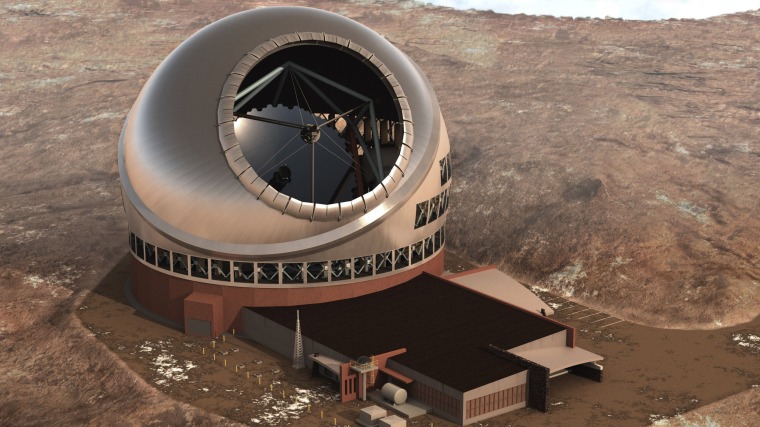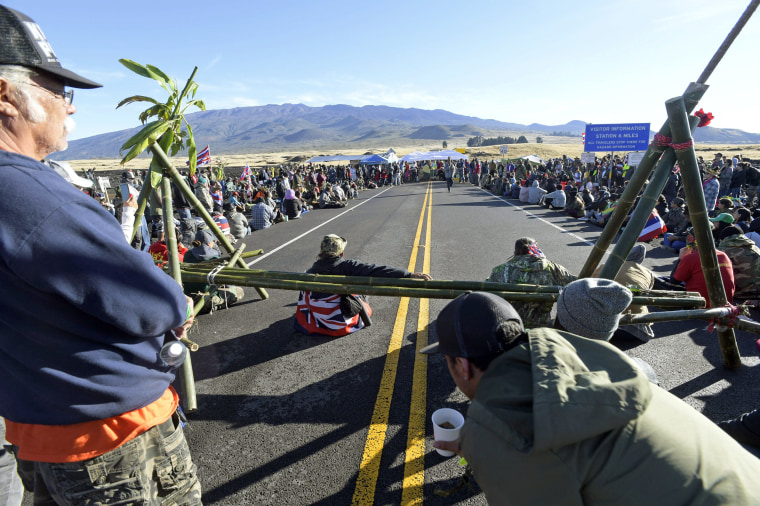A colossal telescope with the potential to revolutionize astronomy and reveal extraterrestrial life is set for construction atop a dormant volcano on Hawaii's Big Island.
But protesters have blocked the road to the summit since July, saying the planned telescope — called the Thirty Meter Telescope (TMT) for the diameter of its huge light-collecting mirror — would desecrate a place that Native Hawaiians deem sacred.
Scientists have been dreaming about such an instrument as far back as the 1990s, and a global consortium of scientists led by the U.S. and Canada completed the TMT design in 2009. But when the group began securing permission from state officials that same year to build the TMT on Mauna Kea's 13,800-foot summit, which is already home to 13 observatories, Native Hawaiians pushed back.
Nearly a decade of legal battles ensued, but Hawaii's Supreme Court ruled in August 2018 that work on the $1.4-billion telescope could proceed. With no other options for stopping construction, protesters formed a human blockade across the road to the summit on July 15 — the week construction was scheduled to begin.
“I was just incredibly grateful for the opportunity to really express how important the Mauna is, not just to me, but to our people, to my children, to the future generations,” says Noelani Goodyear-Kaʻōpua, a professor of political science at the University of Hawaii at Manoa who chained herself to a cattle guard across the road.
The impasse comes at a crucial moment for astronomers, who have maxed out the abilities of existing ground-based telescopes like Hawaii's Keck Observatory and the Gran Telescopio Canarias in the Canary Islands. Big as they are, existing telescopes' comparatively puny mirrors limit their ability to scan light from planets orbiting stars beyond our solar system; astronomers believe these exoplanets hold the answer to the question of whether life on Earth has company elsewhere in the cosmos.
"In our lifetime, we could discover life — evidence of life — off the Earth, which would be one of the biggest things that's ever happened in science," says Michael Bolte, an astronomer at the University of California, Santa Cruz, and a member of the TMT board.
Big science in the crosshairs
This isn't the first time a big science project has run into public opposition, says Robert Kargon, a science historian at Johns Hopkins University in Baltimore. "Ever since the federal government became the leading patron of both basic and applied research after World War II, the funding of science entered the political realm,” he said.
In 1969, as NASA prepared to launch astronauts to the moon, black activists protested at Kennedy Space Center, arguing that NASA funding would be better spent fighting poverty. Protesters descended on Florida again in 1997, when the nuclear-powered Cassini spacecraft was poised for launch to Saturn, sparking fears that an accident would cause an environmental disaster. (The launch went off without a hitch.)

In 2008, two men unsuccessfully sued the organizations building the Large Hadron Collider along the Swiss-French border, arguing that the giant particle accelerator could open up a black hole that would swallow Earth. Fifteen years earlier, a political battle permanently halted construction of the Superconducting Super Collider, another particle accelerator that scientists wanted to build in Texas.
Manua Kea itself has been a flashpoint for controversy ever since the University of Hawaii opened the first telescope there in 1970. But Native and part-Native Hawaiians, who as of 2015 made up 21 percent of the state's population, say they've had little role in the management of Mauna Kea and contend that the 13 telescopes already on the summit have damaged the mountain’s fragile ecosystem.
"TMT should build their observatory in their own ancestral lands, not in mine," says Lilikalā Kameʻeleihiwa, a senior professor at the University of Hawaii's Hawaiʻinuiākea School of Hawaiian Knowledge. "Imagine if TMT were to put its five-acre monstrosity on top of Notre Dame or the Vatican. How would the French or Italians feel? Would they not protest?"
It's a point of view that resonates even with some scientists who long for a massive telescope like the TMT.
"I fear we have forgotten that we are guests," astrophysicist Franck Marchis, a senior scientist at the SETI Institute in Mountain View, California, said in a blog post. "We have been invited into someone else’s home. And we are returning extraordinary hospitality by trampling on sacred traditions."
A contested mountain
The Hawaiian islands were self-governed by native peoples until the U.S. backed an overthrow of the monarchy in 1893, annexed the islands in 1898 and made Hawaii the fiftieth state in 1959.
Hawaii's state constitution requires all land originally belonging to the monarchy be held in a public trust and used to benefit native Hawaiians. That includes Mauna Kea, the islands' tallest landmark. In the Native Hawaiian tradition, the mountain is considered the dwelling place of the Hawaiian deities. Altars and burial sites can be found on Mauna Kea, and it's still used for traditional native Hawaiian ceremonies.
But if Mauna Kea is sacred ground, its predictable weather and above-the-clouds summit makes it one of the best places in the world to observe the heavens. Such conditions exist at only a few places in the world.
As astronomers began erecting observatories on Mauna Kea in the 1970s, a cultural renaissance was sweeping Hawaii. Goodyear-Kaʻōpua says her parents’ generation began embracing their native traditions, learning about their past and teaching the Native Hawaiian language in schools. That cultural groundwork has created a new generation of Hawaiians, including some who say their land was wrongfully annexed by the U.S. more than a century ago.
"These are young people who grew up learning the language, learning the culture and learning the history in ways that their parents and grandparents were denied,” Goodyear-Kaʻōpua says.
The path ahead
Bolte says he's sympathetic to the activists, adding that the TMT consortium has worked for years to address the indigenous community's concerns at a cost of about $300 million. But if no solution to the standoff at Mauna Kea can be found, there may be an alternative: the Roque de Los Muchachos Observatory on the island of La Palma in the Canary Islands.
Already home to 25 telescopes, the site sits at a lower elevation than the summit of Mauna Kea and so has more light-distorting atmosphere to peer through. But there are no cultural concerns that would get in the way.
"Some of the science wouldn't be as doable there," Bolte says. "But it'd be a fantastic facility."
The protesters say that's a small price to pay, and that they aren't budging until the TMT does. Still, Bolte is hoping for a breakthrough that would allow construction to begin on Mauna Kea.
"We’re not talking about a McDonald’s. We’re not talking about an oil pipeline — we’re talking about a telescope,” he says, adding that Mauna Kea is a "window to the universe" for both Native Hawaiians and astronomers alike. "We really failed as human beings if we can't find a way for that to work."
Want more stories about space?
- Call to raid Area 51 draw hordes of alien hunters on Facebook
- Huge asteroid misses Earth but spotlights risk posed by space rocks
- Space aliens are breeding with humans, university instructor says. Scientists say otherwise.
SIGN UP FOR THE MACH NEWSLETTER AND FOLLOW NBC NEWS MACH ON TWITTER, FACEBOOK, AND INSTAGRAM.

